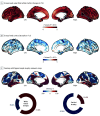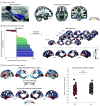Brain Networks for Cortical Atrophy and Responsive Neurostimulation in Temporal Lobe Epilepsy
- PMID: 39348148
- PMCID: PMC11555549
- DOI: 10.1001/jamaneurol.2024.2952
Brain Networks for Cortical Atrophy and Responsive Neurostimulation in Temporal Lobe Epilepsy
Abstract
Importance: Drug-resistant temporal lobe epilepsy (TLE) has been associated with hippocampal pathology. Most surgical treatment strategies, including resection and responsive neurostimulation (RNS), focus on this disease epicenter; however, imaging alterations distant from the hippocampus, as well as emerging data from responsive neurostimulation trials, suggest conceptualizing TLE as a network disorder.
Objective: To assess whether brain networks connected to areas of atrophy in the hippocampus align with the topography of distant neuroimaging alterations and RNS response.
Design, setting, and participants: This retrospective case-control study was conducted between July 2009 and June 2022. Data collection for this multicenter, population-based study took place across 4 tertiary referral centers in Montréal, Canada; Querétaro, México; Nanjing, China; and Salt Lake City, Utah. Eligible patients were diagnosed with TLE according to International League Against Epilepsy criteria and received either neuroimaging or neuroimaging and RNS to the hippocampus. Patients with encephalitis, traumatic brain injury, or bilateral TLE were excluded.
Main outcomes and measures: Spatial alignment between brain network topographies.
Results: Of the 110 eligible patients, 94 individuals diagnosed with TLE were analyzed (51 [54%] female; mean [SD] age, 31.3 [10.9] years). Hippocampal thickness maps in TLE were compared to 120 healthy control individuals (66 [55%] female; mean [SD] age, 29.8 [9.5] years), and areas of atrophy were identified. Using an atlas of normative connectivity (n = 1000), 2 brain networks were identified that were functionally connected to areas of hippocampal atrophy. The first network was defined by positive correlations to temporolimbic, medial prefrontal, and parietal regions, whereas the second network by negative correlations to frontoparietal regions. White matter changes colocalized to the positive network (t93 = -3.82; P = 2.44 × 10-4). In contrast, cortical atrophy localized to the negative network (t93 = 3.54; P = 6.29 × 10-3). In an additional 38 patients (20 [53%] female; mean [SD] age, 35.8 [11.3] years) treated with RNS, connectivity between the stimulation site and atrophied regions within the negative network was associated with seizure reduction (t212 = -2.74; P = .007).
Conclusions and relevance: The findings in this study indicate that distributed pathology in TLE may occur in brain networks connected to the hippocampal epicenter. Connectivity to these same networks was associated with improvement following RNS. A network approach to TLE may reveal therapeutic targets outside the traditional target in the hippocampus.
Conflict of interest statement
Figures




References
Grants and funding
LinkOut - more resources
Full Text Sources

